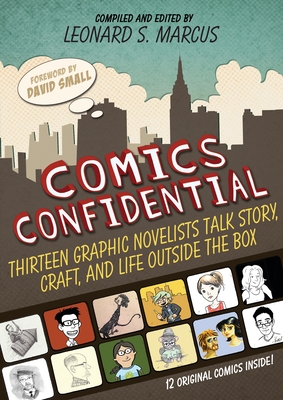
I've only popped open this exquisite work and already have quotes to share:
"Art-making at its best is a confrontation with the mysterious and the irrational. If we listen to the people concerned mainly with classification or marketing, we end up not making honest and true works of art, but only product, rubber-stamped and made to fit into a prefab box that might as well be a casket." David Small
"Without quite realizing it, these indie artists and writers had invented a new art form--a new kind of book for which people at first did not have a name. By the early 2000s, the books were everywhere." Leonard S. Marcus
Whether you call them graphic novels or comics, the current creators are a force in the publishing industry. Comics Confidential, Thirteen Graphic Novelists Talk Story, Craft, and Life Outside the Box, compiled and edited by Leonard S. Marcus, is a documentary treasure of the creative contribution from thirteen viewpoints. Each interview includes a comic and sketches or manuscript pages about "the city." Those nest among personal stories of out of the box artists, including Harry Bliss, Hope Larson, and Sara Varon.
Thank you, Leonard, for stopping and sharing so beautifully the backstories, practices, and thoughts of this group. And thanks, Candlewick Press!
Comics Confidential
Thirteen graphic Novelists Talk Story, Craft, and Life Outside the Box
compiled and edited by Leonard S. Marcus
Candlewick Press, 2016
~Lorie Ann Grover
Viewing: Blog Posts Tagged with: david small, Most Recent at Top [Help]
Results 1 - 25 of 32
Blog: readergirlz (Login to Add to MyJacketFlap)
JacketFlap tags: Candlewick Press, Lorie Ann Grover, david small, Leonard S. Marcus, Comics Confidential, Add a tag
Blog: The Children's Book Review (Login to Add to MyJacketFlap)
JacketFlap tags: Elizabeth McPike, Ages 0-3, Picture Books, Garth Williams, Yuyi Morales, Illustrator Interviews, Oliver Jeffers, Books for Toddlers, featured, Holly Hobbie, Patrice Barton, Andrea Cheng, David Small, Leuyen Pham, Melissa Sweet, Kelly Light, Gabi Swiatkowska, Illustration Inspiration, G.P. Putnam's Sons Books for Young Readers, Poetry & Rhyme, Maria Gianferrari, Add a tag
Patrice Barton’s artistic talents were discovered at age three when she was found creating a mural on the wall of her dining room with a pastry brush and a can of Crisco.
Add a CommentBlog: The Children's Book Review (Login to Add to MyJacketFlap)
JacketFlap tags: Victoria Aveyard, Viking Books for Young Readers, Terry Fan, The Fan Brothers, HarperCollins, Ages 0-3, Ages 4-8, Ages 9-12, Book Lists, Sara Pennypacker, Kevin Henkes, featured, Atheneum Books for Young Readers, HarperTeen, Candlewick, Razorbill, Roaring Brook Press, Jarvis, Judith Viorst, Knopf Books for Young Readers, Cale Atkinson, Doreen Cronin, Megan McDonald, David Small, Dan Gutman, Douglas Florian, Simon & Schuster Books for Young Readers, Julia Donaldson, Jon Klassen, Peter Reynolds, Balzer + Bray, Greenwillow Books, Lydia Monks, Lee White, Disney-Hyperion, Ruta Sepetys, Marissa Meyer, Laura Dronzek, G.P. Putnam's Sons Books for Young Readers, Teens: Young Adults, Julie Falatko, Best Books for Kids, Best Kids Stories, Jessica Khoury, Feiwel & Friends, Jess Keating, Popular Kids Stories, Best New Kids Books, Melissa Landers, Eric Fan, Caitlyn Dlouhy Books, Heidi Heilig, little bee books, Rebecca Roher, Tundra Books, Tim Miller, Vikki VanSickle, Sonia Sanchez, Steve Light, Tommy Greenwald, Add a tag
Blog: The Children's Book Review (Login to Add to MyJacketFlap)
JacketFlap tags: Music, Giveaways, Book Giveaway, Bob Staake, David Small, Margaret Wise Brown, Floyd Cooper, Peter Brown, Blanca Gomez, Molly Idle, Frank Viva, Leo Espinosa, Book and CD, Dadu Shin, Satoe Tone, Song Books, CD Included, Ellie Mackay, Mick Wiggins, Add a tag
Enter to win a copy of Goodnight Songs: A Celebration of the Seasons, by Margaret Wise Brown! Giveaway begins August 4, 2015, at 12:01 A.M. PST and ends September 3, 2015, at 11:59 P.M. PST.
Add a CommentBlog: Barbara O'Connor (Login to Add to MyJacketFlap)
JacketFlap tags: David Small, Me and Rupert Goody, Frances Foster, Beethoven in Paradise, Cynthia Rylant, Add a tag
Ever since I sold my first book a million trillion years ago (okay, okay...1991), I've kept scrapbooks of book-related stuff.
I call them my Ego Books because during those times when I'm feeling insecure and inadequate, like a has-been and a loser (You know you've been there, right?), I can whip one out and thumb through it and I sometimes feel better about myself. (Saves me a ton of money on therapy.)
I read the nice letters folks wrote and see how blessed I am to have lovely, supportive friends and to have achieved some wonderful goals, I'm back in my groove.
So I recently decided to look through them.
Here are some of the highlights from the first one, which is 1991 to 2000.
Blog: Writing and Illustrating (Login to Add to MyJacketFlap)
JacketFlap tags: David Small, Kudos, Clifford the Big Red Dog, Hallie Durand, Norman Bridwell, Jama's Alphabet Soup, Jennifer Reinharz, Christine Brallier, News, inspiration, Add a tag
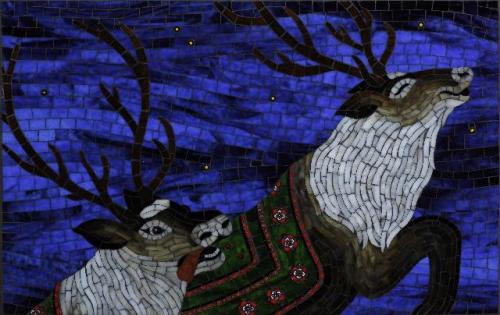
These reindeers created by Christine Brallier are getting ready to take off on their Christmas Eve trip to help Santa deliver his gifts. It is from her children’s book, The Night Before Christmas. The illustrations were created by Christine using stained glass mosaics. http://www.cbmosaics.com/book/
Creator of Clifford the Big Red Dog Norman Bridwell, 86, died last Friday at a hospital on Martha’s Vineyard. Scholastic says his over 150 titles have 129 million copies in print worldwide. Scholastic CEO Dick Robinson said, “Norman personified the values that we as parents and educators hope to communicate to our children – kindness, compassion, helpfulness, gratitude – through the Clifford stories which have been loved for more than fifty years.”
 Jama Kim Rattigan on her blog, Jama’s Alphabet Soup, featured H CATCH THAT COOKIE. I feature the book written by Hallie Drand (A.K.A Holly McGhee) and illustrated by David Small in August. You can click their names to view those posts. But Jama’s post are so much fun. She always ties books in with recipes.
Jama Kim Rattigan on her blog, Jama’s Alphabet Soup, featured H CATCH THAT COOKIE. I feature the book written by Hallie Drand (A.K.A Holly McGhee) and illustrated by David Small in August. You can click their names to view those posts. But Jama’s post are so much fun. She always ties books in with recipes.
I think I am going to try the recipe for the cookies in the post and show them off like she did with the book during Christmas.
Below is a list of the Ingredients, click the Directions at the bottom to jump back over to Jama’s blog to read the rest and see her fun display of her cookies and the book.
GINGERBREAD CUTOUT COOKIES
Total Time: Prep: 30 minutes + chilling. Bake: 10 minutes/batch + cooling.
Yield: 60 cookies
Ingredients:
- 3/4 cup butter, softened
- 1 cup packed brown sugar
- 1 egg
- 3/4 cup molasses
- 4 cups all-purpose flour
- 2 teaspoons ground ginger
- 1-1/2 teaspoons baking soda
- 1-1/2 teaspoons ground cinnamon
- 3/4 teaspoon ground cloves
- 1/4 teaspoon salt
- Vanilla frosting of your choice
- Red and green paste food coloring
 Children’s writer Jennifer Reinharz reported a few months ago that she became a contributing writer at Mamalode. Her second article, A Letter to my Palestinian-American Muslim Friend has been posted. They track the number of unique views, likes, comments, and shares and they base her success on this, so if you get a chance take a minute to read her new article.
Children’s writer Jennifer Reinharz reported a few months ago that she became a contributing writer at Mamalode. Her second article, A Letter to my Palestinian-American Muslim Friend has been posted. They track the number of unique views, likes, comments, and shares and they base her success on this, so if you get a chance take a minute to read her new article.
Jennifer says, “My path to Kidlit author has yet to be a straight line, but I can’t help but think that getting a chance to connect and share one of my stories with the Mommies, etc. is an example of heading right direction.”
This is a goods lesson for all of us. You just never know where your next success will come from and how one little thing can lead to another.
Talk tomorrow,
Kathy
Filed under: inspiration, Kudos, News Tagged: Christine Brallier, Clifford the Big Red Dog, David Small, Hallie Durand, Jama's Alphabet Soup, Jennifer Reinharz, Norman Bridwell
Blog: Writing and Illustrating (Login to Add to MyJacketFlap)
JacketFlap tags: Mark Your Calendars, Studio B, The Making of Storybooks, inspiration, Advice, authors and illustrators, opportunity, How to, David Small, children writing, Hallie Durand, Add a tag
HAPPY LABOR DAY!
Since it is now September, I figured I would post this opportunity for those children’s writers and Illustrators who live within driving distance in Michigan, New Jersey , PA, and New York to met David Small and Holly McGhee.
The third poster down: Studio B in Maplewood, NJ is bringing together five children’s author/illustrators to discuss the process of writing a children’s book.
You can see all the details in the posters below:
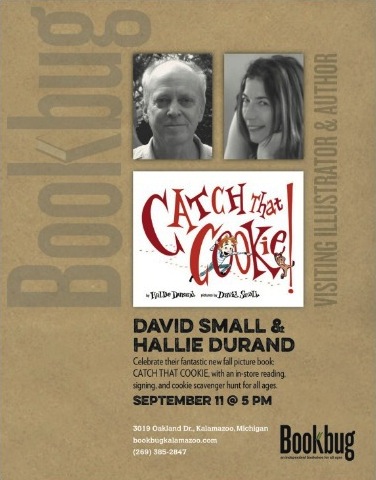
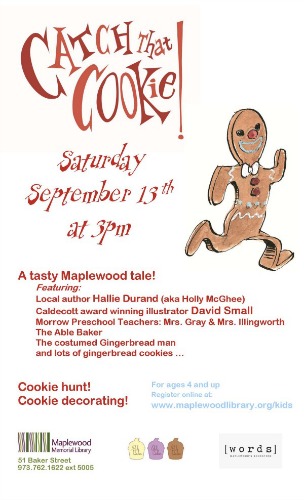
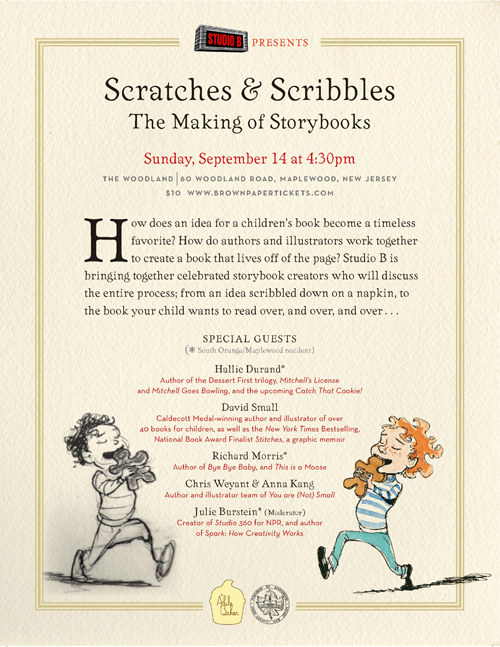
A COMPLETE LIST OF APPEARENCES:
Wednesday, September 10, 2014, 6 P.M., Kalamazoo Public Library
A Conversation with David Small & Hallie Durand
315 South Rose Street , Kalamazoo, MI 49007
Thursday, September 11, 2014, 5:00 P.M., Bookbug, Kalamazoo
Cookie hunt & Book signing
3019 Oakland Dr, Kalamazoo, MI 49008
And here’s the link for that one.
Saturday, September 13 2014, 3:00 P.M., Maplewood Library
Scavenger hunt & Cookie decorating, with a live rogue cookie!
51 Baker Street, Maplewood, NJ 07040
http://www.maplewoodlibrary.org/kids-events/
Sunday, September 14, 2014, 12:00 P.M., Paramus Public Library
Scavenger hunt & Reading, with a live rogue cookie!
E116 Century Road, Paramus, NJ 07652
RSVP 201-599-1309
Sunday, September 14, 2014, Studio B Honcho
Scratches & Scribbles Event for aspiring or already arrived Writers & Artists
60 Woodland Road, Maplewood, NJ 07040
http://www.brownpapertickets.com/event/830322
Monday, September 15, 4:00 P.M., WordsMaplewood Bookstore
Hallie Durand & David Small
Quick Drawing Lesson, Shapes & Contours, & Book Signing
179 Maplewood Avenue, Maplewood, NJ 07040
Talk tomorrow,
Kathy
Filed under: Advice, authors and illustrators, children writing, How to, inspiration, opportunity Tagged: David Small, Hallie Durand, Mark Your Calendars, Studio B, The Making of Storybooks
Blog: Writing and Illustrating (Login to Add to MyJacketFlap)
JacketFlap tags: Catch the Cookie, Yale Graduate School of Art, Interview, Tips, inspiration, Advice, Process, David Small, Caldecott Medal, Illustrator's Saturday, Sarah Stewart, Add a tag
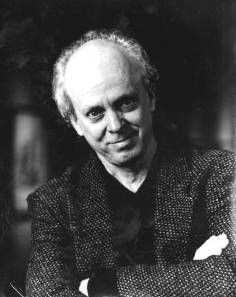 I noticed that illustrator David Small’s new book, Catch That Cookie was hitting the bookshelves on August 14th, so I contacted him to see if he would like to be featured on Illustrator Saturday. He will be doing a book tour in September, so I’ll make sure I tell you all the ins and outs as soon as I know them. It will be a great opportunity to meet him and Hallie Durand, if they are coming to a bookstore near you.
I noticed that illustrator David Small’s new book, Catch That Cookie was hitting the bookshelves on August 14th, so I contacted him to see if he would like to be featured on Illustrator Saturday. He will be doing a book tour in September, so I’ll make sure I tell you all the ins and outs as soon as I know them. It will be a great opportunity to meet him and Hallie Durand, if they are coming to a bookstore near you.
Here is a little bit about David:
David Small was born and raised in Detroit. In school he became known as “the kid who could draw good,” but David never considered a career in art because it was so easy for him. At 21, after many years of writing plays, David took the advice of a friend who informed him that the doodles he made on the telephone pad were better than anything he had ever written. He switched his major to Art and never looked back. After getting his MFA at the Yale Graduate School of Art, David taught art for many years on the college level, ran a film series and made satirical sketches for campus newspapers.
Approaching tenure, he wrote and illustrated a picture book, “Eulalie and the Hopping Head”, which he took to New York, pounding the pavements and collecting rejections for a month in the dead of winter. “Eulalie” was published in 1981. Although tenure at the college did not follow, many more picture books did, as well as extensive work for national magazines and newspapers. His drawings appeared regularly in The New Yorker and The New York Times. A learn-as-you-go illustrator, David’s books have been translated into several languages, made into animated films and musicals, and have won many of the top awards accorded to illustration, including the 1997 Caldecott Honor and The Christopher Medal for “The Gardener” written by his wife, Sarah Stewart, and the 2001 Caldecott Medal for “So, You Want To Be President?” by Judith St. George.
“At the Caldecott ceremony in San Francisco,” said David, “facing that veritable sea of smiling faces — of librarians, of friends in publishing, of my family and other well-wishers— I was so overcome that I lost my voice and croaked my way through the speech. Having been turned from a frog into a prince by the American Library Association, before their eyes that night, I turned back into a frog.” To date he has illustrated over 40 picture books. At an average of 40 pages per book, that makes around 1,840 illustrations, though someone ought to check that math. Currently David is working on a graphic memoir about his problematic youth.
David Small and Sarah Stewart make their home in an 1833 manor house on a bend of the St. Joseph River in southwest Michigan. David’s studio is an 1890 farmhouse also overlooking the river, just a short walk from home.
Here’s David discussing his process for the cover of his new book, CATCH THAT COOKIE written by Hallie Durand:
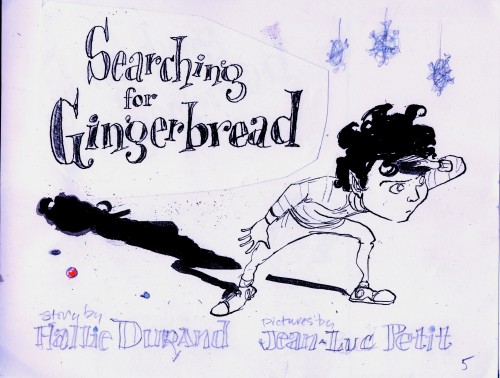
Every picture-book has its unique set of problems in the making of it. This one had relatively few worries on the interior art but, what we didn’t know was: we had a long hard struggle coming up, trying to find a good title and a good jacket design as well. This was a first jacket sketch, from back in the summer of 2013, when the working title was “Searching for Gingerbread”, which nobody liked.

By December, Holly had come up with a great title. I still clung to that original pose for the Kid but, as you can see from my inked notations, we were already discussing a different attitude, one without the theatrical “Scout-Searching-the-Plains” hand over the eyes.

Here the Kid’s pose is more dynamic, but still something was wrong. Nobody thought the Kid should be able to see the Cookie. They were right: it made it look like an uneven match.
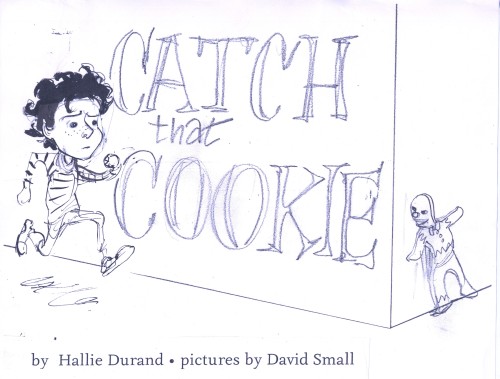
Here their positions are reversed. The hiding cookie seemed okay, but the Kid has no verve. The thrill was going out of this jacket project. By now, six months had passed. It was February 2014, I was working from my studio in Mexico, and our deadline for a jacket was coming up very soon. We decided to get the creative juices kick-started by taking a radically-different approach. (We had no idea what that approach would be, only that it had to be radical. [Slide #4a:] Lily (the Art Director) and I decided to comb over some old movie posters for dynamic image ideas. Here is Mark Wahlberg as “Max Payne.”
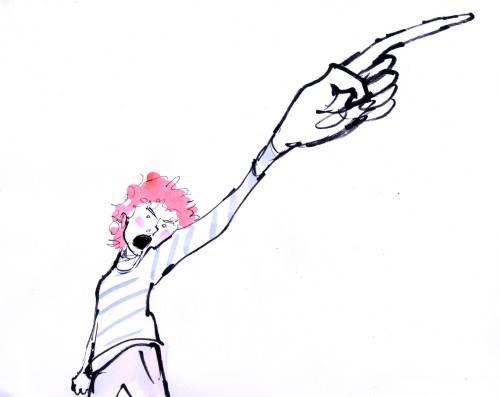
…. and here is the Kid saying: “Stop right there, you darn cookie! Put your doughy little arms up or suffer maximum pain!”
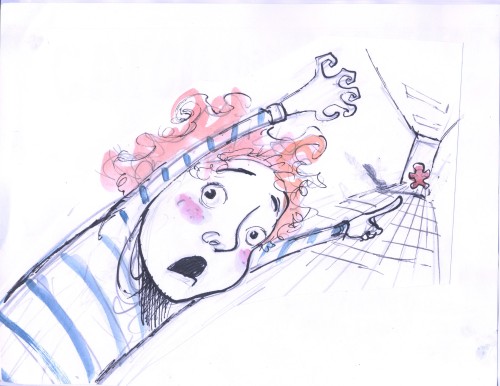
Another wrong direction. The illustrator’s panic shows in the whole pose. I and Lily, Holly and two editors– were working every day, all day and often into the night on this. We had passed the deadline long ago and were nearing the drop-deadline. We had to find another way!

Some smart-thinking person (not me,) had come up with this “WANTED” poster for the back jacket. Another person (also not me,) decided it might work as the front jacket.

For several days we went with that, but nobody was getting buzzed. This one had too much text to read …
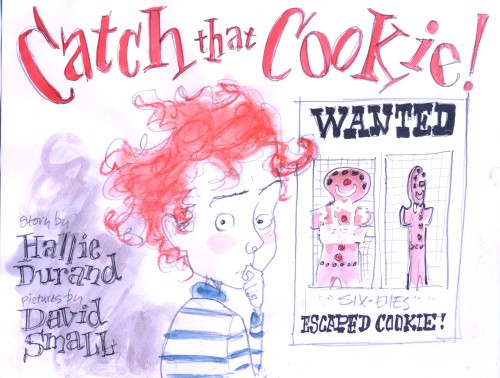
…this had less text but still no “Grab-Me-Off-The-Shelf” appeal.
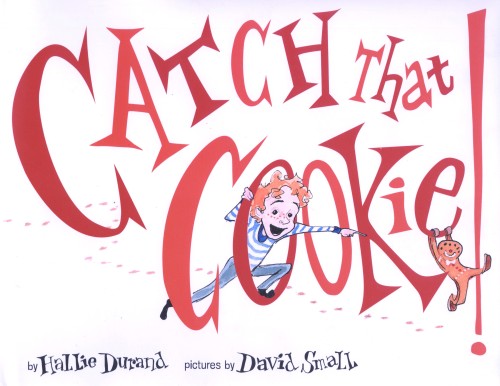
How this– the final jacket design–evolved, was a similar ordeal full of false starts, wrong turns, bad decisions, do-overs and raw nerves but we finally got it. And that, in the end, is all that matters. I’ve shown you 10 examples here, but in my archives I have at least 50 different comps for this jacket, which doesn’t count all the others that went into the trash. It now seems amazing, unusual — even weird– that it took so long to get this right., but so it goes.
BELOW: DAVID ANSWERS TO THE INTERVIEW QUESTIONS I ASKED:
When did you first know you were destined to become an artist?
When I realized I was not fit for life in the real world and that any normal employment was out of the question.
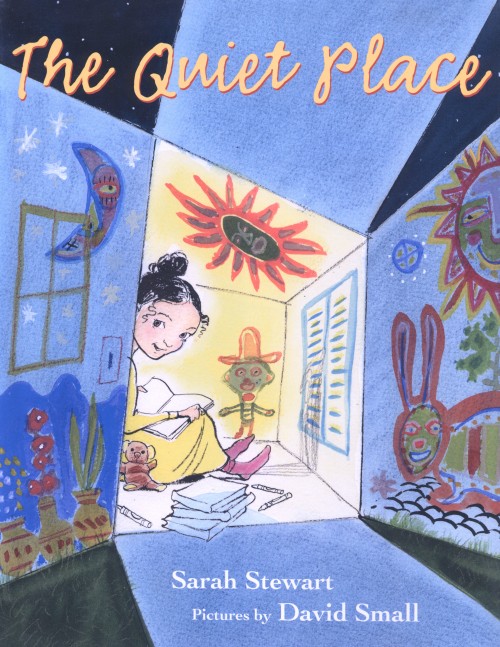
Did you always live in Michigan?
No. I’ve lived in Chicago, in Boston, in New Haven and in a small burg in Upstate New York. Also, you should know that there are two Michigans: one is called Detroit, and I’ve done time in both.
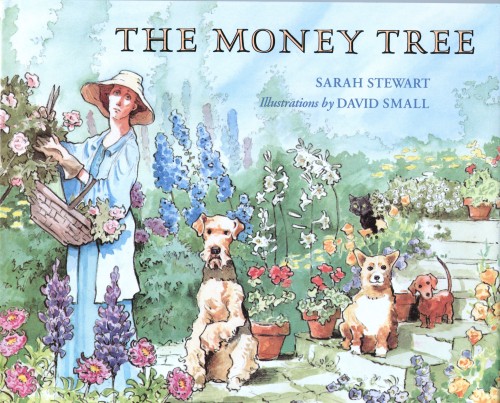
What was the first thing you illustrated and got paid for doing?
An article in the NYTimes Book Review. I was in NYC for 2 months, trying to market my first children’s book. (This was in the early 1980’s, before the Internet, when you had to be in NYC to get work there.) I went up to the Times to the office of Steve Heller, showed him my portfolio, and then and there he gave me an assignment for the Book Review. Since he wanted it the next day, I stayed up all night, working on
the floor of an empty apartment on W. 10th Street. (Some friends had loaned us their apartment while they moved into another one, and the place had no furniture except a bed and a lamp.)
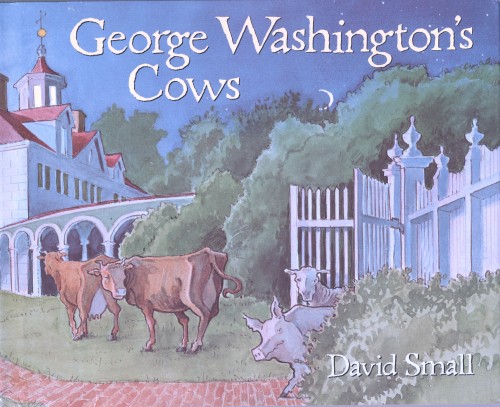
Do you feel getting your MFA at the Yale Graduate School of Art helped develop your style?
No. I had a far better art education getting my BFA at Wayne State University in Detroit, during the ‘60’s.
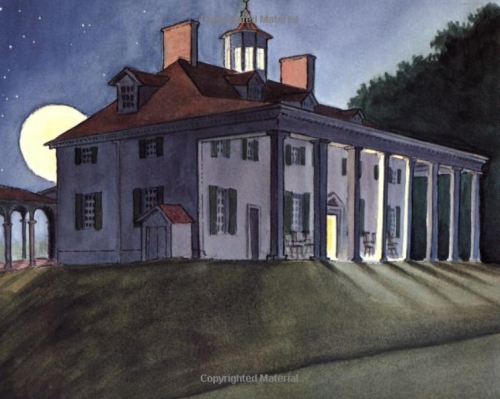
What made you decide to go to Yale vs. other schools for art?
I didn’t make the decision. My mentor– a Boston artist named Michael Mazur–decided I needed to go to grad school. Mike had gone to Yale, was good friends with the printmaker Gabor Peterdi, who at that time taught in the Printmaking Department at Yale, and he used his influence to get me in.
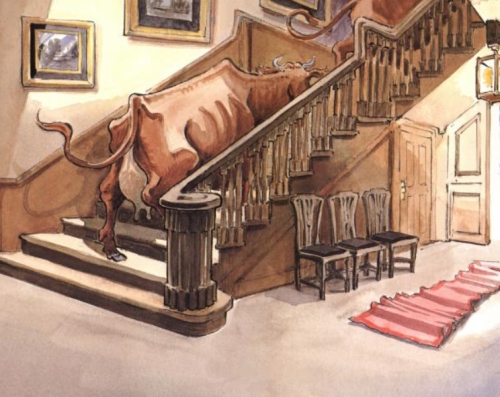
Did you have a favorite class at Yale?
Life Drawing was always my favorite class, wherever I was. At Wayne I had had great instructors in drawing the figure and Anatomy, so by the time I got to Yale all I really needed was to be left alone to continue practicing.
You may sense a certain “distant” tone when I speak about Yale? At the time I was
there, in the early 70’s, the Yale Grad School of Art was a ruptured institution, with one part of the faculty –the Traditionalists–at war with another, the Abstractionists. This tension got passed along to the students, who basically stayed hidden away in their studios, coming out only for the faculty group critiques of their work. These forums were staged in public, in an open pit, with people watching from the balconies tiered around that space. They were like gladitorial games and they always devolved into ideological screaming-matches between the professors, while students were frequently driven away in tears. I got spared these ordeals because we Printmaking majors weren’t considered actual artists.
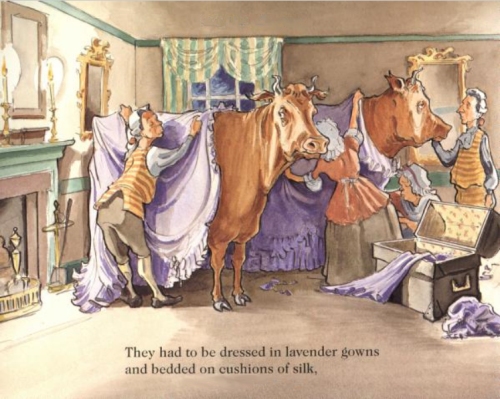
You mention in your bio that you began with writing plays. Do you think you will ever write another play?
Making graphic novels is much like play writing, and it’s even more like film-making.
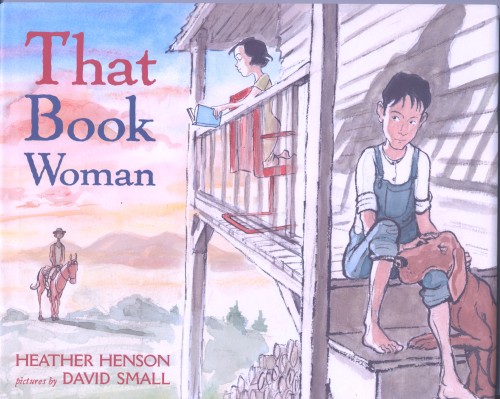
Do you feel getting your MFA at Yale opened doors for you?
Absolutely. In the world of academe, that Yale degree has genuine snob appeal. Out in the world of actual illustration, Art Directors at magazines and publishing houses could care less where you went to school. They don’t read your resume, they just look at your portfolio.
My opinion of art schools in general is they offer you two important things: 1) a place to work where you can avoid having to be out in the world while you develop your art, and, if you’re lucky, 2) possibly one or two good instructors who might encourage you. I still think the portfolio is more important than the degree.
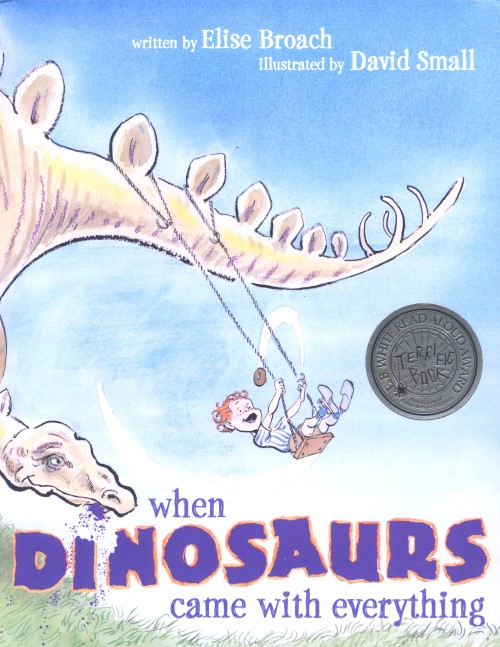
What was the catalyst for your first picture book, “Eulalie and the Hopping Head”?
My family. I grew up feeling my parents wanted to trade me in for a different model.
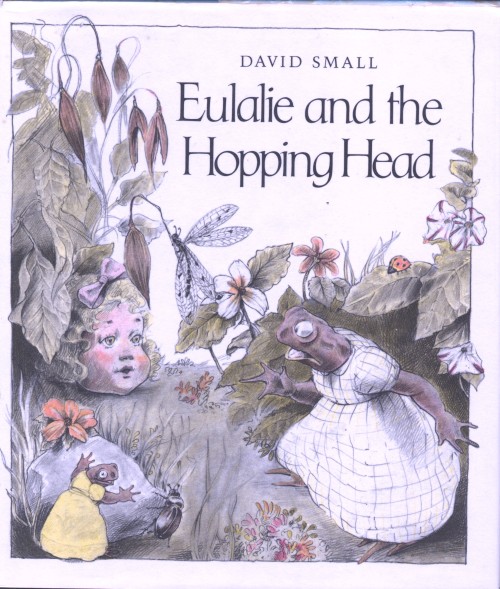
Where did you teach art? How did the job to teach art come along?
I first taught at the S.U.N.Y. college at Fredonia. I presume it was the Yale degree that put me in the running for that position, but also, my work was substantial and I interviewed well. That job lasted 7 years. I left that institution -and tenure — when I was hired at Kalamazoo College ,which had all the qualities I was looking for in a place to teach; it was small, it offered a real quality education, it had that
Georgian architecture ( the look of a little Parnassus-On-A-Hill) and –a big plus–there were very few Art majors. That meant that my students came from other disciplines like the sciences and language, and so, had other interests than flinging paint around.
After 4 years there, the Reagan Recession hit and colleges everywhere began cutting positions to save money. My position was eliminated and my wife and I –both around 40 years old at that time– found ourselves out on the street, with no jobs, no savings and no place to live. At the time it seemed like a disaster, but it turned out to be the best thing that ever happened to me. It pushed me out into the world of work. If I had stayed in academe I think I might have withered away and dried up completely.

How did you land your gigs with The New Yorker and The New York Times?
I showed them my portfolio and, to my surprise, they hired me. Then they hired me again. But there was absolutely no certainty that they would ever hire you after that. This uncertainly–to me– was exhilarating, and stillis. It’s so different from academia, where you could relax and be assured that your next paycheck would be coming in.

Do you still do illustrations for magazines?
No. Maybe things have changed now, but for the years when I worked for magazines, the work was always very interruptive, the pay was low, and it all had to be done very fast. The pace got even crazier with the advent of fax machines, overnight delivery and the Internet.
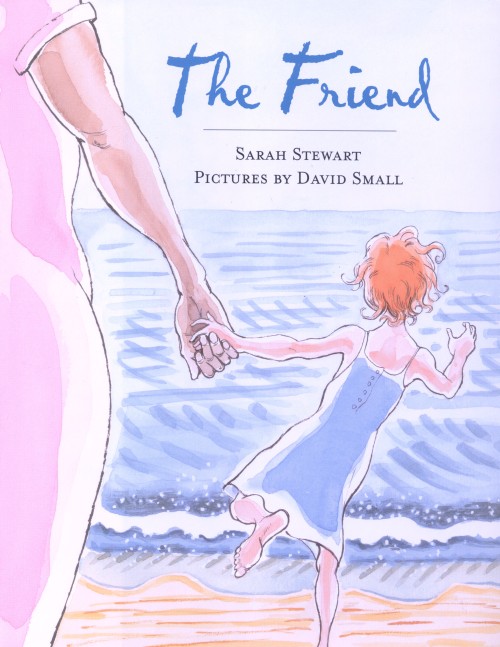
Which books of yours were recreated into animated films and musicals?
IMOGENE’S ANTLERS was made into a great little mini-musical. Weston Woods has made films of SYWTB President?, MY SENATOR AND ME, and– coming soon– ONE COOL FRIEND.

Did your illustrating and your wife’s writing bring the two of you together?
No. A mutual friend introduced us at a party and it was love at first sight. I loved her face, her intellect, and the tiny vase of live violas she wore around her neck that night. We were friends for eight years before we married.
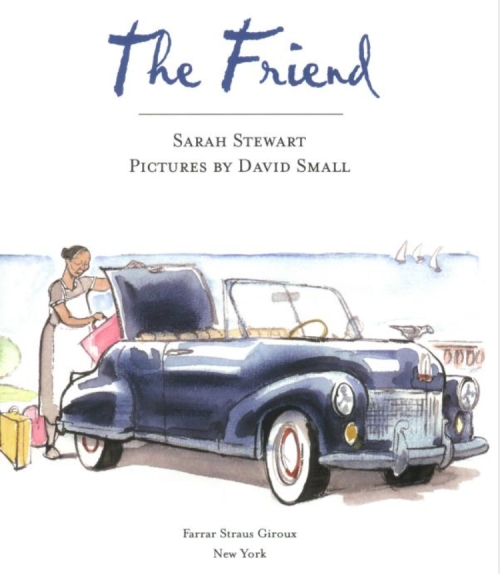
Was it fun working on “The Gardener” that your wife Sarah Stewart wrote?
The word “fun” did not enter my work vocabulary on that project The story ,as you know, is set in the Great Depression, and concerns a child whose family can’t afford to keep her. She is torn away from everything she knows and loves and is sent off to work for her uncle in the city. When I illustrate a story I have to make my own. That is, I have to find myself in it. With The Gardener, at first and for a long time, I agonized over the pain and loneliness that child must have felt. I couldn’t find any light in it. Also, I was familiar with the black and white photos from that era, of the
starving families in the Dust Bowl, of the urban bread lines … It wasn’t pretty. I decided it was beyond my powers to illustrate that story, and I was ready to turn back the contract. Then came a breakthrough.
I had a talk with Lydia Grace Finch–the gardener friend of Sarah’s on whose childhood Sarah had based her story. I asked Lydia what it was like growing up during the Depression.She said: “I was just a kid like any other kid. I didn’t know what ‘the Depression’ was; that was just life. We all had to work, of course.
We worked hard, but we also knew how to enjoy ourselves. I had a lot of fun during the Depression!”
That conversation was an eye-opener for me. I put it together with my own childhood memories of growing up young and innocent in Detroit, and suddenly things began to develop rapidly on paper. I guess, maybe, at that point it started to be fun.
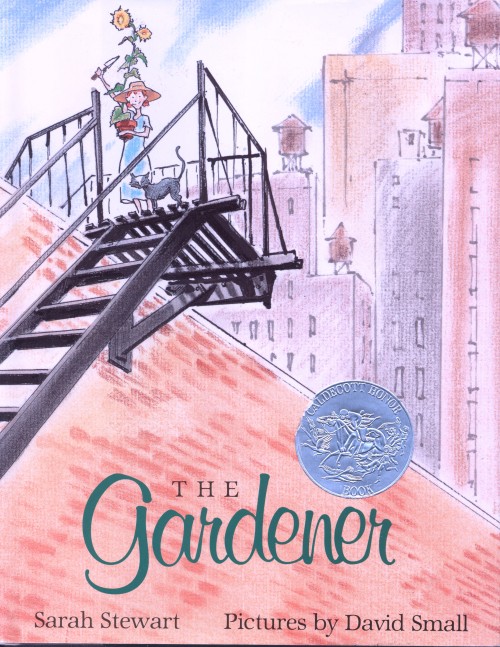
How excited were the two of you to win The Christopher Medal and receive a Caldecott Honor for that book in 1997?
Very excited and surprised as well. It was stunning for both of us, to have such a private, personal experience given such huge recognition by the larger world.
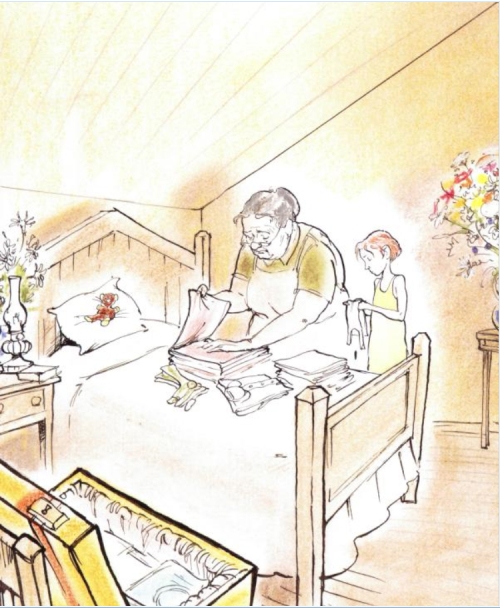
Did you see a jump in demand for your illustrating after those wins?
I suppose I did. I know I started getting offered a lot of manuscripts that resembled Sarah’s but that weren’t Sarah’s, so I really had no interest in doing them.
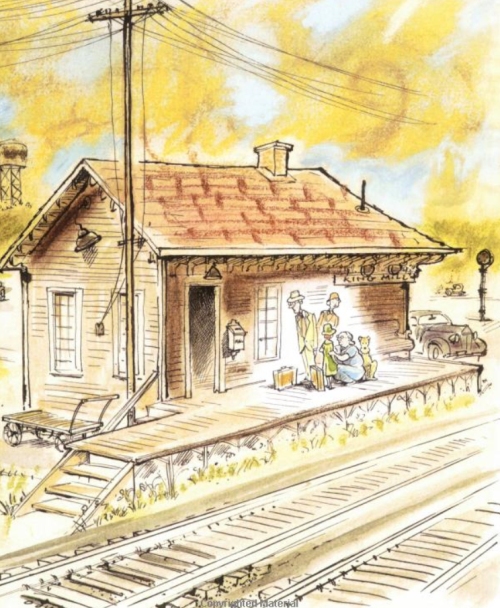
Did you have any idea that “So, You Want To Be President?” by Judith St. George would win the Caldecott?
I personally didn’t think that book would sell five copies. But, speaking of “fun?” … that book was fun to make! Maybe that’s why I had little hopes for it, because it seemed more like bad-boy misconduct than work.
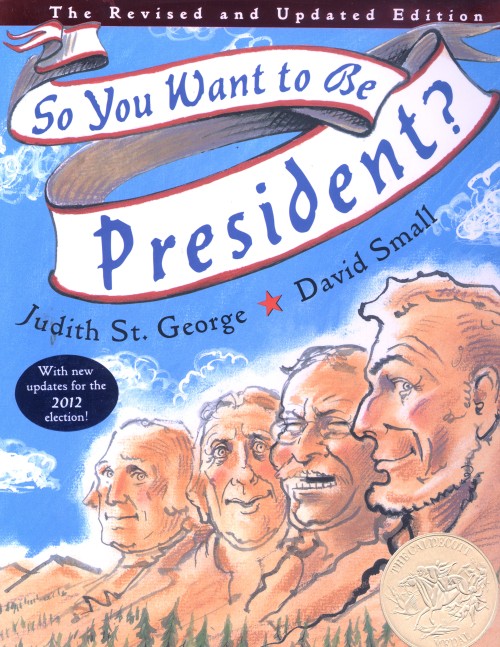
Once we realized that a Presidential election (Bush v. Gore) was coming up that very Fall, we stepped up the production schedule and I had to work very quickly; I didn’t have time to fuss and fret over every drawing. So, maybe my pessimissim about its prospects was related to my anxiety that maybe I hadn’t done a “perfect job”. (Aways a worry.)

Was Imogene’s Antlers the second picture book that you wrote? How did you find a home with a publisher for that book?
It was the fifth book I had illustrated, the second book I wrote. The editor of my first book– Alan Benjamin– had just become the Senior Buying Editor at Crown. Nobody among the higher-ups at Crown wanted to buy that book, but Alan made them publish it. He had a sense about it. He and I shared that bad-boy quality in our taste for books, but Alan was also very suave, very urbane, and could be very persuasive.
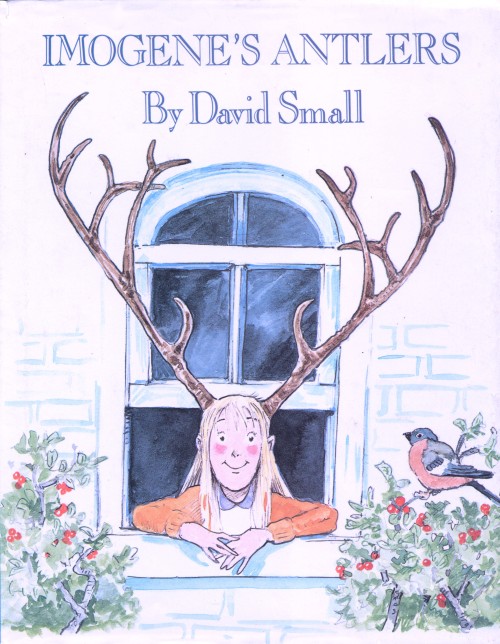
When did you meet your agent Holly McGhee?
It must have been 1997, the year she began Pippin Properties. I had given up on my search for a literary agent because all of the ones I met, for one reason or another, I had found disturbing. (One of them — a very famous kids book agent– was an outright crook. I had been warned away fromhim by several of my peers, but I interviewed him just to see if they were right. They were right. He met all red flag points on the official “How To Recognize a Sociopath” list. After that creepy encounter I had decided to go back to being agentless.
Then, Holly McGhee wrote to me. Her letter not only showed a genuine interest in– and enthusiasm for — my work, but she already had an impressive list of clients including William Steig and Jon Agee. When I met her face-to-face and found myself talking not to a self-inflated suit but to a genuine, straight-talking human being, I was convinced. I knew that she could help bring some business clarity to my life.
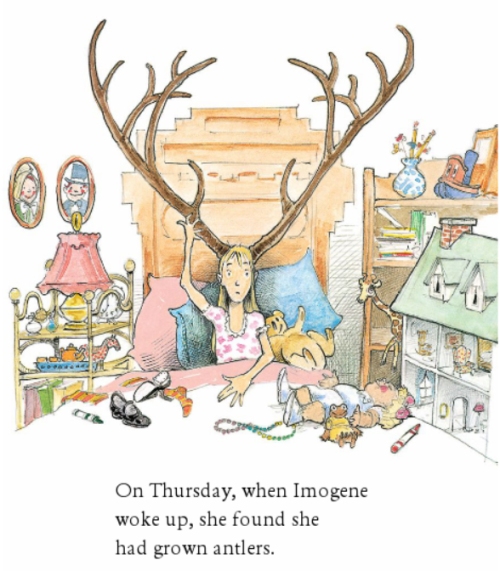
Were you Holly’s first client?
I was not the very first, but I was among them.
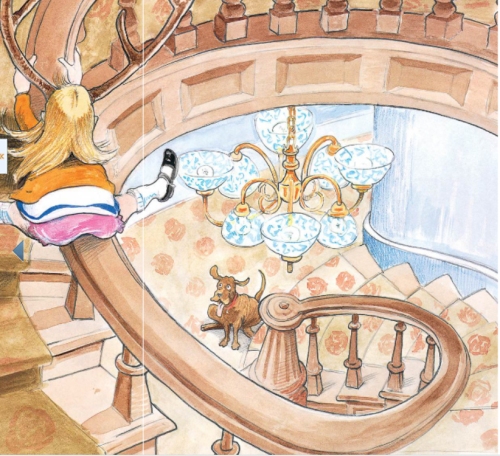
Was it hard to write “Stitches,” since it is so heartfelt?
It took me about 7 years to make that book, and yes, it was very very hard to make. But, that being said, I was driven to do it. All the false starts, all the re-do’s, the frustrations and self-doubts, the piles of material that ended up in the trash and the fifteen full-length versions (all of them different) were just things that seemed very necessary to working out a coherent story.
Holly, by the way, was very involved with Stitches from the beginning. She edited the first 12 versions of it. When we finally had it in a form she thought she could present with confidence, she spent a whole year of research to find a list of 6 editors at 6 different houses where she thought my book would fit. After that, she and the other Pips spent months putting together a presentation package. About that, Holly said, “I want this thing to be so extraordinary-looking that an editor will immediately
pop it into their briefcase and read it on the train ride home.” The day after she sent it out she immediately got 5 offers.
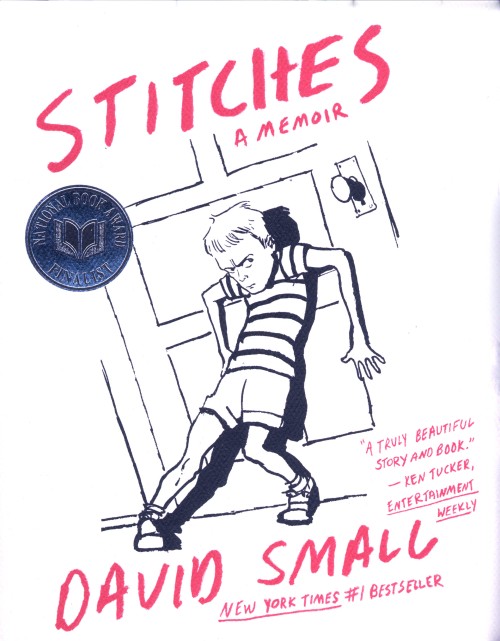
Was that your first graphic novel?
Yes.
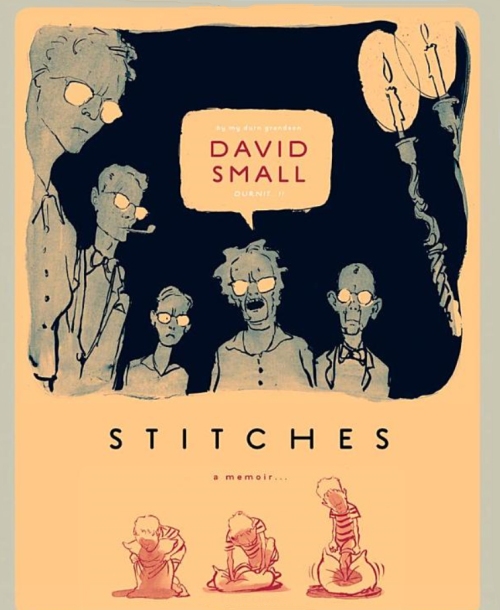
Which one of your books is your favorite?
Stitches is the book of my life, okay?–but it is in a much, much different category from the picture books. Of those, The Money Tree (by Sarah ) and my own Paper John were probably the most meaningful, because they both were pulled up from some place very deep in us both. As for the 50+ other picture books, I have to give the by-now cliched but still very-honest answer: I don’t play favorites with my children. That said, there are a few of those children who–although I wish them well– I’d prefer not to see again. You try the best you can every time, but sometimes the stars are misaligned …. something has gone wrong.
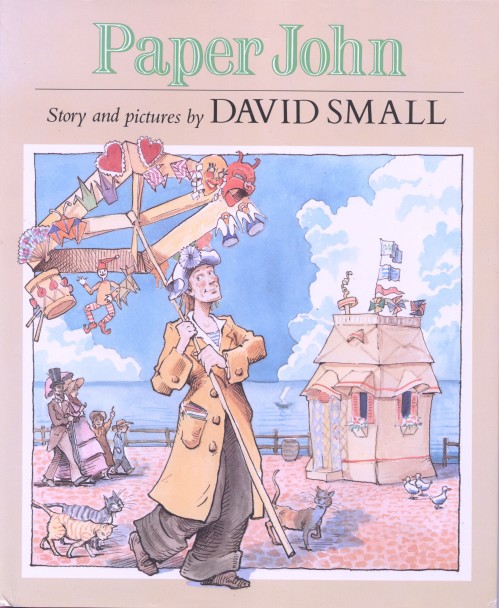
What is your favorite material to us when you do a colored illustration?
I first draw in waterproof ink, then do the color in water color and pastels.
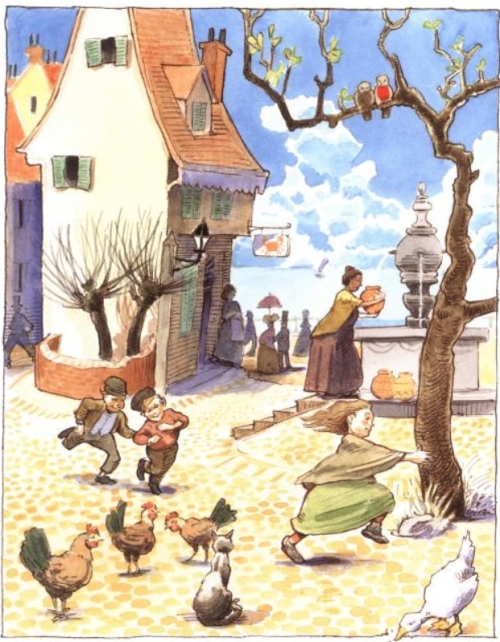
Have your materials changed since your first published book?
Yes. By the time I did So, You Want To Be President? I was getting tired of Realism and was ready for a change in both my style and materials. That was when I loosened up my drawing style, began drawing more with a brush, and working in some patches of pastel chalk, for more emphatic color.
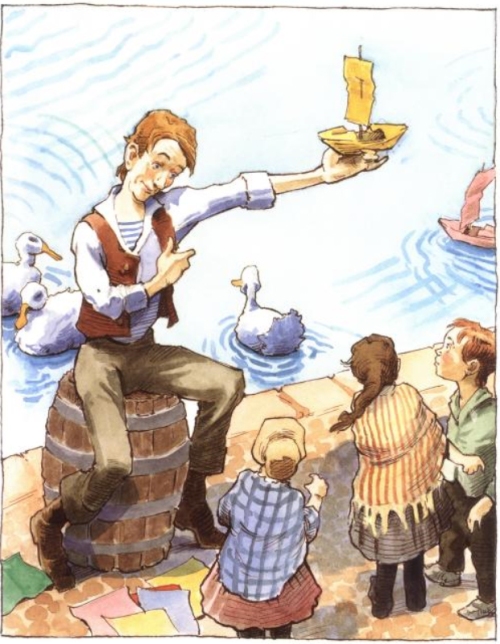
Have you tried your hand at Photoshop or drawing with a graphic tablet?
I have. Like everyone else in this ramped-up age of publishing, I was seduced by the “apparent” speed with which changes can be made with the computer, and by some of the impressive effects achieved by a few of the artists who use it. But, when I started taking Photoshop lessons I realized that I disliked more things about the medium than I liked. Most of all I missed the disconnect between the hand and the image. I missed having inky fingers and masses of art supplies surrounding me. I found out that being able to make speedy changes was not necessarily a good a thing for me: it felt strange that a drawing could be instantly evaporated into the ether, without having time to mellow and to reveal its good aspects. I should add that, when I go to an exhibit of original art I prefer to see original hand-made art, not a digital print-out. From the former I feel I’m always learning something useful about what the human hand is capable of doing, while from the latter I generally learn nothing. I also see a lot of computer artists trying clumsily to imitate the effects of
hand-drawn work. I’m not saying I’m against digitally-generated images, I’m only saying it’s not for me.
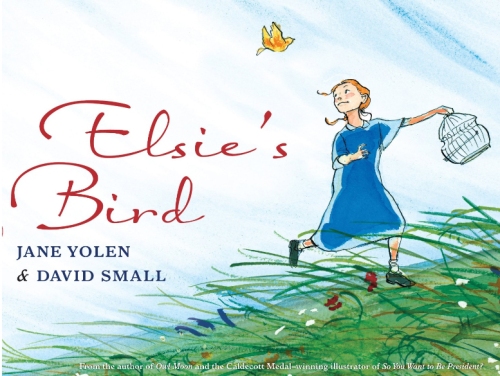
Do you spend any time promoting your work or does Holly take care of all that for you?
I spend Zero time in self-promotion. I’m not on Facebook or Twitter. Holly is my advocate, my procurer (heh) , my confessor, my confidante, occasionally (as with Stitches,) my first editor and one of my best friends. As Artistic Director of her own company now, she chooses the best artists and authors she can find, gets them the best contracts she can, and lets their work stand for itself.
Promotion is up to the publishers and their Marketing Departrments. What makes them get behind a book –or not– is always a mystery, but I have to trust them. In any case, I’d much rather have them out there, doing all that, than doing it myself. I have other fish to fry.
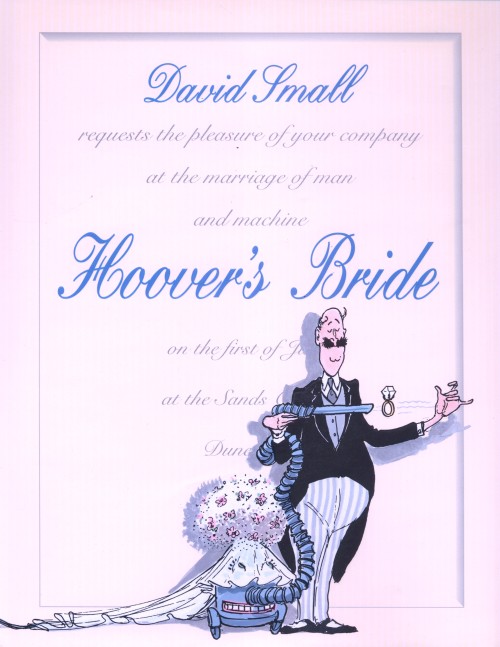
What do you feel was your greatest success?
You can have many different kinds of success. There are books that might have been commercially successful that were not, in your own opinion, so successful as works of art or literature. There are books you are very proud of from an aesthetic standpoint, which sink without a trace. There are books that have a big critical success but which, for some reason, the public doesn’t go for. I’ve had all of these.
The 2001 Caldecott Medal ceremony was the most astonishing public display of success I’ve ever experienced. I think almost everyone present, that night in San Francisco, felt that something really significant had been done by the ALA. The crowd was immense and the air was electric. There was something very daring and spirited about the committee’s choice that year. I am sure it had something to
do with the political miasma swirling in D.C. at the time, and with the sense that Judy St. George, our editor Patricia Gauch and I had delivered some straight-talk to American children about the real human beings–full of real talents and real faults — who have held the highest office in the land. So, it was an enormous thrill being at the center of all that , but what I felt mainly was a fearsome lack of words with
which to express adequate thanks to the givers.
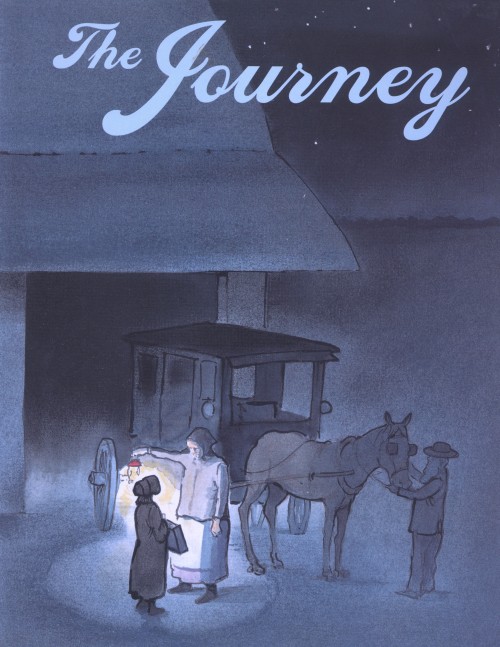
Since you have a separate studio, would you tell us a little bit about it?
We have two houses on our property. One is the house we live in, the other–a 3-minute walk along the riverbank– is my studio, which occasionally doubles as a guest house. When I used to work at home Sarah and I found the intertwining of our lives too distracting. Sarah needs absolute silence, while I need music on, sometimes very loud, when I work. Sarah likes to leave the phone off the hook, but I don’t
mind interruptions. I enjoy emails, while Sarah has never touched a computer and won’t have one in the house. Those are significant differences, but we both share a need for privacy, so having separate work spaces –when we finally got them–was a big relief. That being said, I have to tell you that Sarah never once complained while I was at work at home, but, when the opportunity came along for me to have a studio, she was on it like spots on dice.
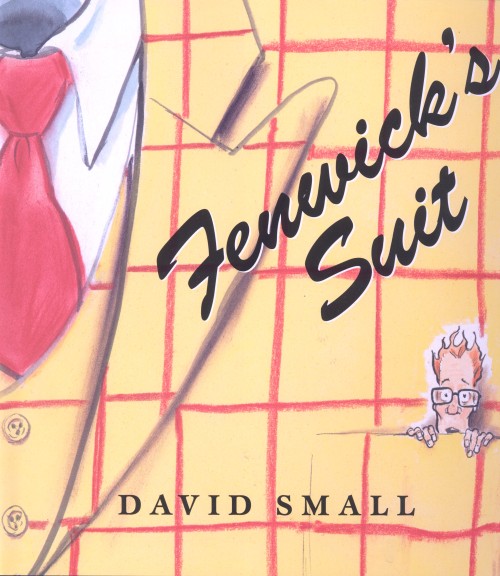
Do you try to spend a specific amount of time working on your craft?
No. I don’t have a stopwatch for the amount of time I put into my work , just as I don’t go over my Profit & Loss sheets. I pay no attention to time and I pay even less to money. If I paid attention to those things, my worries would be all about time and money. As it is, my worries are all about art.
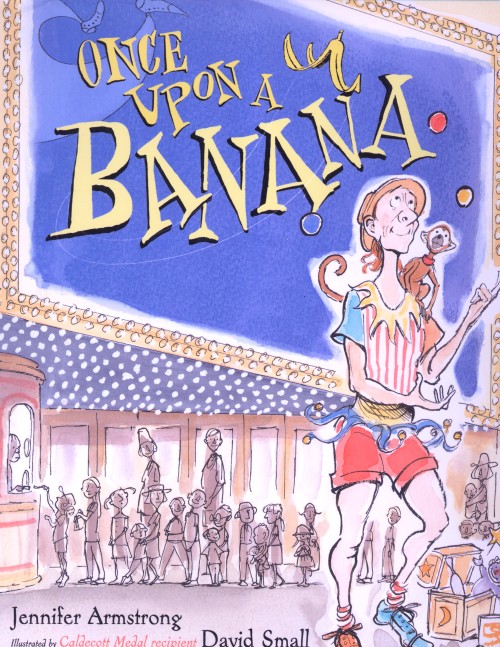
Do you take pictures or do any types of research, before you start a project?
For things like architectural styles and period costumes one must have research tools, books and the Internet. Computers are amazing tools for this, but I cherish equally my collection of books, which is big. A book is a often a better research tool, especially when you don’t know specifically what you’re looking for, you often find it by leafing through the pages.
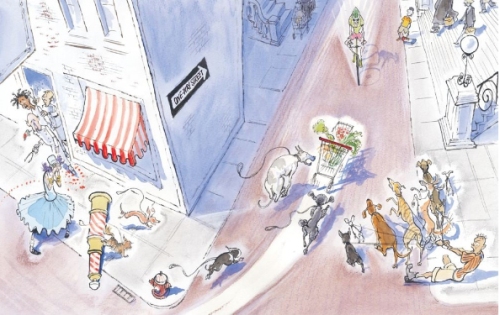
Do you think the Internet has opened doors for you?
Oh yes! I live on a prairie outside a small farming village, Population 800. There is a distinct lack of culture out here. We have a very small library, but nothing else, no museums, no theatres. Even though Chicago and Detroit are only 3 hours distant, we visit them only occasionally and for very brief stays. With e-mail I communicate daily with business friends, editors and art directors in NYC and with close friends in
Boston, San Francisco, Mexico, Paris and Brazil. It’s fantastic.

Do you have any career dreams that you want to fulfill?
I hope to keep working and to fall over into my ink bottle when I croak. If there is an afterlife I hope they have a good art supply store there.
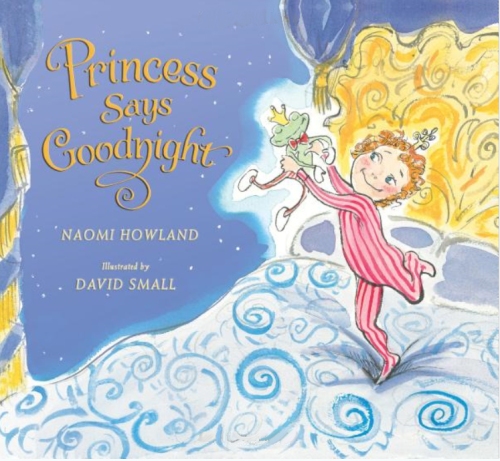
What are you working on now?
I have a book coming out with Dial this September, CATCH THAT COOKIE! written by Hallie Durand. Next year will see GLAMOURPUSS by Sarah Weeks (Scholastic, Spring 2015.) At the moment I’m working on finals for BLOOM by Doreen Cronin (Atheneaum, Spring 2016.) I also have a graphic novel in the works. That will be published by Liveright.
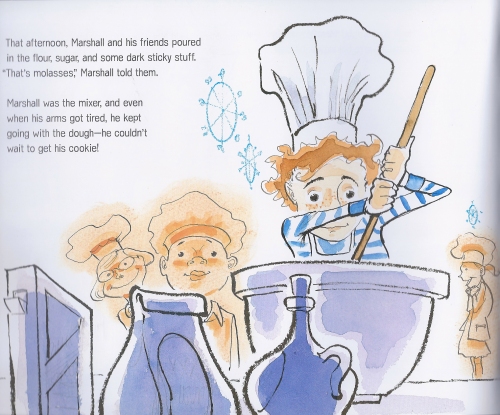
Do you have any material type tips you can share with us? Example: Paint or paper that you love – the best place to buy – a new product that you’ve tried – A how to tip, etc.
A few years ago I fell in love with a refillable brush pen made in Japan and distributed by Pentel. I buy mine from Wetpaint in St. Paul MN. (On their website store, click on Brush Pens and it will be the first item listed.) I drew most of Stitches with that pen, and I always travel with them to use in my sketchbooks.
As for”How To” tips, I have two good ones:
A. Always carry a sketchbook with you and use it. If you’re self-conscious about people watching you, wear tinted glasses and develop a “don’t mess with me” look. (You are, after all, at work, and you have to focus at all costs.)
B. If you’re learning watercolor, try to put down no more than three layers of color, the first having so little paint in it that you can hardly detect any color. This advice comes from good old John Ruskin’s “Elements of Drawing” (1857.) When I can calm my own impatient impulses and follow it, a painting usually works out beautifully. When I forget Ruskin’s tip, my painting gets muddy and has to be done again.
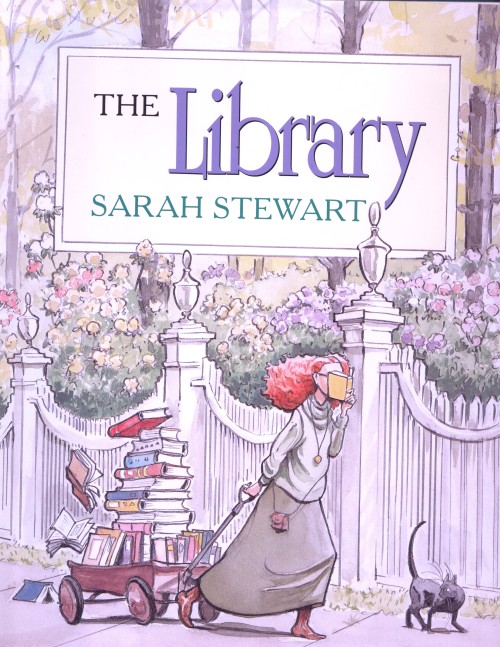
Any words of wisdom you have on how to become a successful illustrator would be appreciated?
Sure. Don’t think about being a successful illustrator. Just try being a great one. Copy the old Masters.
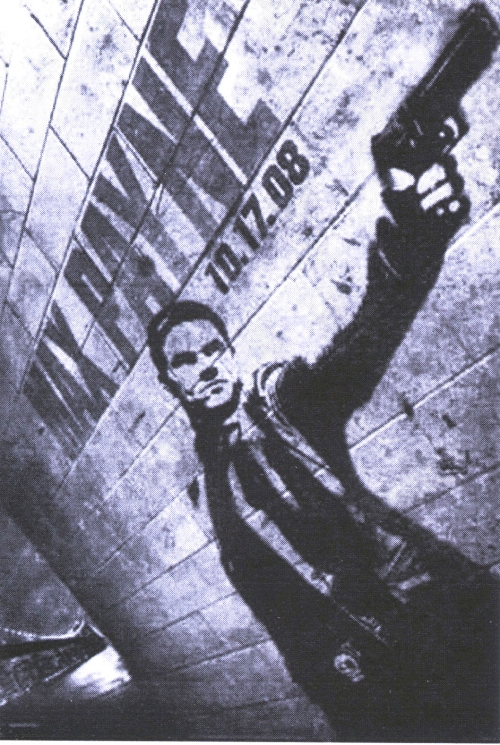
Thank you David for sharing your journey, expertise, and process with us. Good luck with CATCH THE COOKIE. I hope it is a big success.
Here is the Amazon link for anyone who wants to check it out: CATCH THAT COOKIE by Hallie Durand. Can anyone tell me who is Hallie Durand?
You can visit David at his website: http://www.davidsmallbooks.com
Please take a minute to leave David a comment. I am sure he would love to hear from you and as always, I would, too.
Talk tomorrow,
Kathy
Filed under: Advice, Illustrator's Saturday, inspiration, Interview, Process, Tips Tagged: Caldecott Medal, Catch the Cookie, David Small, Sarah Stewart, Yale Graduate School of Art
Blog: Hazel Mitchell (Login to Add to MyJacketFlap)
JacketFlap tags: lemony snicket, Simon and Schuster, Loren Long, toni buzzeo, Ellen Hopkins, jon sciezka, David Small, Ashley Bryan, justin chanda, Hazel Mitchell, the fantastic flying books of Mr morris lessmore, ala anaheim, Add a tag
So last week I shared a bit about my experience at ALA. Here is the rest of the dirt. This time no pictures of me (possibly), just fawning over famous-er and hugely (brilliantly) talented people (and therefore this post will get lots of hits).
Seriously.
It was like Wonderland (or WondLa- land, but I didn't get to see Tony DiTerlizzi). A famous face at every turn. Fun to say hi, to have a chance conversation, to meet a hero and be inspired. Here are some inspiring moments and inspiring people ...

Blog: A Fuse #8 Production (Login to Add to MyJacketFlap)
JacketFlap tags: Uncategorized, David Small, The Library, Top 100 Picture Books Poll, Sarah Stewart, Add a tag
 #51 The Library by Sarah Stewart, illustrated by David Small (1995)
#51 The Library by Sarah Stewart, illustrated by David Small (1995)
37 points
All my favorite things—stacks of books and bookshelves of books and libraries full of books! – Ellen L. Ramsay
This is my daughter. This is me. We don’t care about dances, or even doing our chores other than haphazardly, it is all about the books. And in the end, we find that kindred spirit who shares our same tastes and we spend our time together drinking tea and reading books. What a life! - Christine Kelly
When I read this book long ago (the publication date says 1995 so maybe not THAT long ago) I was a bit disturbed by this title. A 20-something year old will be. I mean, it’s about someone who spends the best hours of their life reading. But as I got older I came to understand the Elizabeth Browns of the world. This is one of those picks that appeals particularly to the librarians and booksellers of the world.
The description from my Amazon review reads, “Our heroine is Elizabeth Brown and our heroine’s method of entering the story is to fall from the sky into her mother’s outstretched laundry linen. Says the text, ‘Elizabeth Brown/ Entered the world/ Dropping straight down from the sky/ Elizabeth Brown/ Entered the world/ Skinny, nearsighted, and shy.’ From the beginning the girl is an avid reader. With her constant companions at her side (a stuffed teddy bear and a continually serene housecat) we watch as Elizabeth Brown goes to school and breaks her own bunk bed with the weight of her books. She lends them to friends and eschews the lure of the opposite sex. Older still, she starts tutoring and lives on her own, reading all the while. Then one day there’s no denying it any longer. ‘She had to face the awful fact.’ There are just too many books in the house. Without further ado her house becomes a library and she moves in with a female friend. To the end of their days they continue to read, ‘And turned page… after page… after page’.”
Once again I’d like to mention that this fall we’ll be seeing a whole new David Small / Sarah Stewart collaboration. I’ve seen bits of it and all I can say is that it will KNOCK your friggin’ socks off. That is all.
School Library Journal (which is to say, Trev Jones) said of it, “This is a funny, heartwarming story about a quirky woman with a not-so-peculiar obsession. Cheers for Elizabeth Brown, a true patron of the arts.”
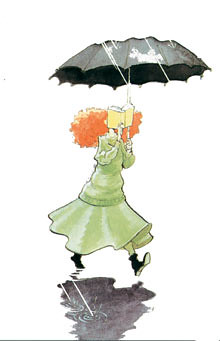
Blog: A Fuse #8 Production (Login to Add to MyJacketFlap)
JacketFlap tags: Sarah Stewart, Uncategorized, The Gardener, David Small, Top 100 Picture Books Poll, Add a tag
 #92 The Gardener by Sarah Steward, illustrated by David Small (1997)
#92 The Gardener by Sarah Steward, illustrated by David Small (1997)
21 points
Written as a series of letters, this book shows the beauty of nature and the importance of hard work. Also a great read for adults, especially those who remember and were effected by the Great Depression. – Gina Detate
Previously the book was #94 on the list and like Where Is the Green Sheep? it hasn’t deviated much from its original spot. This is one of those books that have lasted as long as they have thanks to their superior husband and wife teamwork. I am therefore very pleased to announce that we will be seeing yet another David Small/Sarah Stewart collaboration published from Macmillan (I believe) this coming fall.
If this poll is good for nothing else, it’s very useful in terms of me digging up my old reviews. Here’s a description I found in a review that I wrote for Amazon back in 2004: “The year: 1935, and Lydia Grace Finch is being sent from the country to go live with her Uncle Jim in the city. Lydia Grace faces this challenge with resolve and a little sadness. After all, she is leaving her family behind and the effects of the Great Depression having taken their toll. The city is a gray dirty place and Uncle Jim is kind but he never smiles. Soon it’s Spring again and Lydia has found a place to call her own (the building’s abandoned roof). Her number one goal is to get Uncle Jim to smile, and she’s fairly certain that the answer to this problem is just around the corner.”
I’ve heard more than one person tell me that of all the Sarah Stewart/David Small pairings out there, this one is their favorite. I may have to agree. Truly, though, it was put best by Anita Silvey who said of the title, “When this book appeared in 1997, I thought it a wonderful re-creation of the Depression Era for children. Now it seems to me an even more important book. With children who might well identify with a parent out of work or having little money, the book speaks to the true American can-do spirit. Make beauty where none exists; plant victory gardens; transform useless landscapes into those that produce food and joy; reuse and recycle. The Gardener can be used to talk about all of these contemporary issues. It continues to send its readers off to find that “bit of earth,” whether in vacant lots, window boxes, or well-laid-out garden beds.”
Publishers Weekly said, “This inspiring offering from creative collaborators (The Library) gets much of its vitality from what it leaves unsaid.”
Said SLJ, “This is a story to share one-on-one, talking about the pictures together and then poring over the details alone.”
Blog: Galley Cat (Mediabistro) (Login to Add to MyJacketFlap)
JacketFlap tags: Uncategorized, David Small, Neal Pollack, Sean Beaudoin, Art Edwards, Teddy Wayne, Ernessa T. Carter, Robin Antalek, Patrick deWitt, Claude Clayton Smith, D. R. Haney, Elizabeth Eslami, Greg Olear, Matthew Baldwin, Nathan Larson, Nathaniel Missildine, Richard Cox, Simon Smithson, Vernon Lott, Add a tag
 A group of authors have teamed up for the Writing Off Script: Writers on the Influence of Cinema digital anthology, a book of essays raising money for the Joplin Schools Tornado Relief Fund.
A group of authors have teamed up for the Writing Off Script: Writers on the Influence of Cinema digital anthology, a book of essays raising money for the Joplin Schools Tornado Relief Fund.
The authors (listed below) will write essays on how movies have influenced their work. Follow this link to read an essay from the collection. Cynthia Hawkins will edit the anthology and Simon Smithson of Calavera Books will publish it on December 1st.
Here’s more about the fundraiser: “[Proceeds] will go to the Joplin Eagles Television 14 Program through the Joplin Schools Tornado Relief Fund. The JET 14 Program instructs 160 students each school year in the fundamentals of film production and broadcasting. During the F-5 tornado that struck Joplin, Missouri on May 22, 2011, 54% of Joplin’s students lived in the path of the tornado, eight schools including the city’s high school were destroyed or significantly damaged, and one teacher and seven students were killed.”
New Career Opportunities Daily: The best jobs in media.
Add a CommentBlog: PaperTigers (Login to Add to MyJacketFlap)
JacketFlap tags: Monica Brown, John Parra, IBBY, International Youth Library, Munro Leaf, David Small, The Story of Ferdinand, Lulu Delacre, The Storyteller's Candle, Ethiopia Reads, Biblioburro, Jeanette Winter, Heather Henson, That Book Woman, World Literacy, My Librarian is a Camel, Margriet Ruurs, PaperTigers personal views, Dashdondog Jamba, Lucia Gonzalez, Abigail Sawyer, Speaking in Tongues, Mongolia Children's Mobile Library, mobile libraries, Danlyn Iantorno, Sydelle Pearl, Books for Children of the World: The Jella Lepman Story, elephant delivery project, Jambyn Dashdondog, The Librarian of Basra, The Library Train Bangkok, Waiting for the Biblioburro, wheelbarrow library service, Add a tag
Abigail Sawyer regularly reviews books for us here at PaperTigers, and she’s also, in her own words, “a lifelong library lover and an advocate for access to books for all”, so who better to write an article for us about “unconventional libraries” and the children’s books they have inspired. Abigail lives in San Francisco, California, USA, where her two children attend a language-immersion elementary school and are becoming bilingual in English and Mandarin: an experience that has informed her work on the blog for the film Speaking in Tongues. I know you’ll enjoy reading this as much as I have.
On Traveling Libraries and Heroic ‘Book People’: Inspiring children’s books about getting books to people in remote places and difficult circumstances
 My sons and I paid our first-ever visit to a bookmobile over the summer. For us it was a novelty. We have shelves of books at home and live just 3 blocks from our local branch library, but the brightly colored bus had pulled up right near the playground we were visiting in another San Francisco neighborhood (whose branch library was under renovation), and it was simply too irresistible. Inside, this library on wheels was cozy, comfortable, and loaded with more books than I would have thought possible. I urged my boys to practice restraint and choose only one book each rather than compete to reach the limit of how many books one can take out of the San Francisco Public Library system (the answer is 50; we’ve done it at least once).
My sons and I paid our first-ever visit to a bookmobile over the summer. For us it was a novelty. We have shelves of books at home and live just 3 blocks from our local branch library, but the brightly colored bus had pulled up right near the playground we were visiting in another San Francisco neighborhood (whose branch library was under renovation), and it was simply too irresistible. Inside, this library on wheels was cozy, comfortable, and loaded with more books than I would have thought possible. I urged my boys to practice restraint and choose only one book each rather than compete to reach the limit of how many books one can take out of the San Francisco Public Library system (the answer is 50; we’ve done it at least once).
 The bookmobiles provide a great service even in our densely populated city where branch libraries abound. There are other mobile libraries, however, that take books to children who may live miles from even the nearest modern road; to children who live on remote islands, in the sparsely populated and frigid north, in temporary settlements in vast deserts, and in refugee camps. The heroic individuals who manage these libraries on boats, burros, vans, and camels provide children and the others they serve with a window on the world and a path into their own imaginations that would otherwise be impossible.
The bookmobiles provide a great service even in our densely populated city where branch libraries abound. There are other mobile libraries, however, that take books to children who may live miles from even the nearest modern road; to children who live on remote islands, in the sparsely populated and frigid north, in temporary settlements in vast deserts, and in refugee camps. The heroic individuals who manage these libraries on boats, burros, vans, and camels provide children and the others they serve with a window on the world and a path into their own imaginations that would otherwise be impossible.
Shortly after my own bookmobile experience, Jeanette Winter‘s Biblioburro (Beach Lane Books, 2010), a tribute to Colombian schoolteacher Luis Soriano, who delivers books to remote hillside villages across rural Colombia, arrived in my mailbox to be reviewed for Paper Tigers. I loved this book, as I do most of Winter’s work, for its bright pictures and simple, straightforward storytelling. Another picture book, Waiting for the Bibiloburro by Monica Brown (Tricycle Press, 2011),  tells the story of Soriano’s famous project from the perspective of one of the children it
tells the story of Soriano’s famous project from the perspective of one of the children it
Blog: Hazel Mitchell (Login to Add to MyJacketFlap)
JacketFlap tags: Hazel Mitchell, Paul O Zelinsky, Alice Through the Looking Glass, SCBWI Los Angeles, Fighting Monkeys, Marla Frazee, children's illustration, David Small, Add a tag
That's what going to LA SCBWI Summer Conference feels like. Wandering into a fantasy world populated by fantastical authors and illustrators, new friends of all nationalities, heads on sticks and, um, fighting monkeys.
Let me explain:
Fantastical authors - Gary Paulsen, Bruce Colville, Judy Blume to mention a few. That fantastic enough for you?
Fantastical illustrators - Paul O' Zelinsky, Richard Jesse Watson, Denise Fleming, David Small, Kadir Nelson, Marla Frazee, Jerry Pinkney. Amazing.
Someone said to me that being at the LA conference was a lot like speed dating, and you know it sums it up. Awesome people everywhere you turned and so little time before rushing off to the next great breakout session.
Did I learn a lot? Yes. Did I make new contacts? Yes. Did I have a good time ... er, yes :-)
The heads on sticks and fighting monkeys will be explained by the following photos ...
Fred Koehler, Sheri Barnes, Moi, Debbie Ohi, Russ Cox
Blog: The Official SCBWI 10th Annual New York Conference Blog (Login to Add to MyJacketFlap)
JacketFlap tags: Sarah Stewart, picture books, Inspiration, david small, Add a tag
 |
| Sarah Stewart |
If you don't remember anything else, Sarah said, remember these two quotes:
Whenever Flaubert was asked for the true identity of Madame Bovary, he would say, "C'est moi."Children listen differently, Sarah told us. Much more honestly to one another and in their speech.
"If it doesn't come from deep inside of you, forget it," Sarah said. "It's not going to go across the world."
And then, E.B. White, when asked about writing to little children, said, "I write up to children. They are my most discerning audience."
She exhorted us to leave the room if we weren't willing to go deep with our work: "The blank paper stares at me unblinking, unforgiving, daring me to write a meaningful line. If you're not prepared to fling yourself, body and soul into your writing for the rest of your lives, you should rise up and flee out of this room right now."
And she gave us three words to live by: expect, protect, and reject.
Expectation: By this, she means to expect a lot of yourself and expect a lot of your reader. Honor that desire to know in all of us, she said ... the insatiable curiosity in nearly every child. The openness that is so natural for the very young. At the same time, acknowledge the best in yourself. Be quiet. Search within your own unique experience. Take the time you need. Take the time that you and your writing deserve. Remember that only in long silences are we able to hear our most inner selves.
Expect to finish what you've started. "Small miracles can come from the simple act of finishing a story," she said.
Expect a lot of yourself and write up to the child with honesty.
Protection: She urged us to "Protect yourself from Internet invasion and family chaos and work stress in any way that does no harm to your relationships. Get up before everyone else. Ask for quiet time in the family when appropriate. If you work away from home, if you can, eat lunch occasionally and take notes. Eudora Welty said, 'Writing is a muscle. If you don't use it every day, it will let you down. It will diminish'."
Protect your brain. Eat well and exercise. You'll not only write better, you'll feel better. And when you're called up onstage to receive the award for your next book, you'll even look better.
Rejection: Reject the shallow connectedness of the web. Without being selfish or rude, give yourself and your own thoughts as much time as possible.
You do not have to be the most popular person ... to be a great writer. You have to write, and write some more, and then start again and write it better.
When you do send a story off and it gets rejected, remember that it's the story being rejected--and not you. And so put that story away. Let it rest. Don't look at it for months. Write another story. Get out from under that rejection.
Sarah read to us from three classic books (check them out for inspiration):
- The Grinch by Dr. Seuss
- Sylvester and the Magic Pebble by William Steig
- The Crows of Pearblossom by Aldous Huxley
Blog: The Official SCBWI 10th Annual New York Conference Blog (Login to Add to MyJacketFlap)
JacketFlap tags: LA11, Inspiration, illlustration, david small, keynote, Add a tag
It's a great morning. Donna Jo Napoli was up first, David Small is up now. If you haven't visited David's website, it is full of fantastic sketches from his travels and helpful links. For a hint at his demo on Monday and a quick interview, visit this post.
Besides visiting David's website, I would say PLEASE take a moment to read the posts about him on Julie Walker Danielson's Seven Impossible Things. Her review of STITCHES alone makes me tear up.
David shares this video with us:
It's pretty harrowing, be sure you've had your breakfast and a hug for the day.
David tells us making STITCHES was the therapy he couldn't get any other way.
David needed to find a way to bring his family back, to recreate and remember them to figure out if his adulthood nightmares, anxieties, and anger are rooted in his childhood or just chronic depression.
But as David is sketching and drawing and writing down his childhood memories, he comes to the conclusion:
"I had an unloving mother who wanted me dead. And I believe it's safer to keep expressions like that away from the body, and get them out through art or music..."
David is still reticent to talk about the making of STITCHES in public, so he's structured the rest of his talk about it as a Q&A.
Why the switch from picture books to an older audience/graphic novels?
David quotes Dante,
Midway upon the journey of our life
I found myself within a forest dark,
For the straightforward pathway had been lost.
Deciding he needed to drop all the metaphors in his life and start looking at REAL life, David wanted some good therapy, but:
"Out on the prairie, you don't have access to the perfect psychoanalyst, so I became that for myself... by writing and drawing this memoir... and I always expected myself to get over 'it.'"
What would you like readers of this book to know?
When all is said and done, STITCHES is a warning about families with wrong-headed tradition. A long conga line of people abusing their children who go on to abuse their children... David reads Philip Larkin's poem:
Though David now has a brighter view of life than Mr. Larkin, and he's stepped out of that conga line he mentions, it's still a daily struggle for David to be sure he's treating his loved ones the right way.
"So now, after being the downer of the morning, I will try to be the upper, too."
David shows us a video called UNCHAIN MY HEART. A rousing, hilarious animatic of a typical day on an author tour. While I STRONGLY OBJECT TO THE PORTRAYAL OF MEDIA ESCOR
Blog: First Book (Login to Add to MyJacketFlap)
JacketFlap tags: Sarah Stewart, Mo Willems, Mitali Perkins, Books & Reading, Authors & Illustrators, Roger Sutton, Rosemary Wells, Marla Frazee, First Book, John Green, David Levithan, Laura Amy Schlitz, children's book authors, Rebecca Stead, Holly Black, Jacqueline Woodson, Leonard Marcus, M.T. Anderson, Lois Ehlert, John Scieszka, Tad Hills, Judith Viorst, kid's books, Tony DiTerlizzi, David Small, Kyle Zimmer, Laura Geringer, Christopher Paul Curtis, E.B. Lewis, Erica Perl, Andrea Davis Pinkney, Add a tag
A collection of our favorite authors and illustrators sat down to help us tell the story of First Book:
The Story of First Book from First Book on Vimeo.
Blog: Cheryl Rainfield: Avid Reader, Teen Fiction Writer, and Book-a-holic. Focus on Children & Teen Books (Login to Add to MyJacketFlap)
JacketFlap tags: Uncategorized, book review, children's book review, picture book review, david small, imogene's antlers, Add a tag
written and illustrated by David Small.
Reading level: Ages 4-8
Publisher: Crown Books for Young Readers/Random House
ISBN-13: 978-0375810480
My rating: 5 out of 5 stars
Looking for a funny, laugh-out-loud picture book? Check out Imogene’s Antlers by David Small. It is SO funny, and has beautiful illustrations! It’s written and illustrated by David Small.
The story goes into fantasy–a little girl, Imogene, wakes up one morning with antlers. At first she encounters some problems (getting dressed, getting out the door), but then she also discovers some fun–hanging donuts off the antlers, feeding birds that way, having her mother faint. Imogene clearly enjoys her new experience. I think kids will delight in the adults’ reactions–her mother fainting away (twice), the principal getting bugged, the doctor unable to find anything wrong.
The text is beautiful–just enough to tell the story, but not overdoing it. Short sentences that tell us so much. I wish more writers wrote like this. And the illustrations! They are gorgeous–so full of life, light-hearted and happy, fun and funny.
The ending is also a delight–when it appears that the next morning, Imogene has been “cured”–only to see that she’s got a huge peacock’s tail attached. This is a funny, feel-good book. It’s one of those books I think both children and adults will enjoy.
I highly recommend it.
source: review copy from the publisher, in exchange for an *honest* review. (I do not review books I don’t like.)
Blog: Art, Words, Life (Login to Add to MyJacketFlap)
JacketFlap tags: SCBWI, Illustration, David Small, favorite illustrators, Add a tag
Children's Illustrator
An interview with David Small.
(Via Fans of SCBWI on Facebook.)
Blog: I.N.K.: Interesting Non fiction for Kids (Login to Add to MyJacketFlap)
JacketFlap tags: illustrations, book recommendations, Susan E. Goodman, David Small, 2009 titles, Graphic Novels, inspiration, Add a tag

One of the first entries I wrote for this blog was about reading Philip Isaacson’s Round Buildings, Square Buildings, and Buildings that Wiggled like a Fish long ago—how its beauty and complexity blew me away and made me realize that nonfiction for kids could be an art form and I wanted to try writing it. http://inkrethink.blogspot.com/2008/05/book-that-started-it-all-for-me.html
When Stitches was nominated for a National Book Award in the kids category, I figured I should read it. I had read a few graphic novels before, some okay, some very good, but they didn’t change my reading habits much. No aspersions cast, there are many types of books I don’t read much.
Stitches had me at hello. I would love to say it was literary merit alone, but it was actually because Small's first spread had a single word on it—DETROIT. I live in Boston now, but come from Detroit and have very strong feelings about it.
His second spread had a panel with a row of postwar houses built for returning GIs—one of them looked exactly my childhood house. As subsequent panels slowly drew us toward and inside his home, I noticed his address was 19458. Mine was 18073. As a nonfiction writer, it didn’t take long for me to find out that Small had lived on Pinehurst, not my street, Sorrento. Nevertheless, the hook was set.
It was Small’s story and how he told it that reeled me in, though. Especially that amazing interplay between word and image, where pictures are telling the story, then language carries the narrative baton for a little while, only to pass it off to an image where emotion and action are so perfectly aligned that it takes you someplace else entirely. I was trying to explain this to a friend and she said, “Like a picture is worth a thousand words, basically?” “No,” I answered. “Like the picture does something no words could do.” Examples in this book—pp 62-63, 174, and 250 for starters.
This is not a new insight. Millions (multi-millions) have always known it and I guess I did to. But there’s a difference between knowing something and feeling the one-two punch of its impact, especially within the context of a story. Thank you, David Small, for whacking me over the head.
Blog: A Chair, A Fireplace and A Tea Cozy (Login to Add to MyJacketFlap)
JacketFlap tags: ww norton, reviews, graphic novels, memoir, cancer sucks, david small, 2009, Add a tag

Stitches: A Memoir by David Small. W.W. Norton & Co. 2009.
About: David Small's childhood. As a young boy, he senses the unhappiness and secrets around him. At fourteen, he has an operation to remove a cyst. The aftermath involves scars and loss of voice. And loss of innocence, what is left, when he later discovers that the repeat X-rays given him by his radiologist father to cure various ailments caused the cancer.
The Good: In an interview with David Small at Smith, Small says "Ours may be the last generation to carry on the traditions of selfish, silent, confused and confusing behavior in our family."
The reader is introduced to the secrets of the Small family as six year old David visits his Grandmother. First we hear of her tough life; we meet her and find out she's not a sweet Grandma. Why are such secrets kept? Such silent pacts maintained? Fear? Shame? Or is it a twisted selfishness, because it seems easier to keep those secrets?
The ultimate combination of secrets and silence is the surgery on Small, for cancer, though its a year before he's told this. Literally silenced by the surgery (and accordingly silenced by his father, as it's the radiation treatments from the father that causes the cancer), Small has no avenue for his anger. Anger at his surgery and physical limitations, and anger at a mother who takes her unhappiness out in silence and slammed doors, and anger at a father who disappears into work and office. Scarred by their inactions and words, literally carrying the scar on his body.
Small is sent to boarding school and runs away; psychiatric help is advised, and, reluctantly and angrily his parents send him. It turns out to be the single best thing they ever done for their son, because it saves him.
At the end, even though Small has survived, and found art, and made a life for himself, there is a profound sense of sadness. Sadness for the child and teen David, who was failed by his family. Sadness for his mother, whose own mother was clearly mentally ill, who had ongoing physical problems from a birth defect (her heart was literally in the wrong place), who is a closeted lesbian. Sadness for his father, who did not mean to harm his child, yet almost caused his death; stuck in a marriage that will never bring happiness. As for Small's brother, he is practically a ghost in this book, not really present. Perhaps that is how Small felt as a child; or perhaps it is because this is a memoir, not an autobiography, and Small feels it's not his place to tell his brother's story.
While there is sadness for his parents... never does my pity trump the simple fact that both these adults failed their child. Failed in the lies they kept, and the silences, which in turn created a life and home with no emotional safety. Others can go into the art of this book better than I; but for me, part of the reason this story is so devastating and intimate is that it is told with pictures more than words.
What else? I love the idea of young David putting a yellow to
Blog: Biblio File (Login to Add to MyJacketFlap)
JacketFlap tags: Graphic Novel, memoir, Adult, David Small, Add a tag
Stitches: A Memoir David Small
This graphic novel memoir tells of David Small's early life, how he was often sick and how the treatment at the time-- frequent sinus x-rays, ended up giving him throat cancer, robbing him of his voice. Moreover, it's a look at parents who didn't love each other, and a mother that didn't love him.
What I wanted more of was his story of emotional and mental recovery. The bulk of the book is devoted to his awful childhood, and the end rushes through the explanation of how he overcame that. There's a brief paragraph at the end, where he relates information about his mother that he learned later in life that allows him to be more sympathetic to her. I wanted more of that shown in the book, not just as a note in the back matter. I'm much more interested in stories of overcoming adversity, not stories of a crappy life. Small fulfilled his dreams of becoming an illustrator, but we're not shown or told how. I'm inclined to agree with Tyler Cowen, who says "This much-heralded story of a sick child, mistreated by his parents, struck me as professionally done but pointless."
But, oh, it is so beautifully done. I (think) it's watercolor and pencil, all shades of gray. Here's a (rather low-quality) picture of my favorite panel, showing Small's isolation after the removal of the tumor leaves him voiceless:

It was the art that wouldn't let me put it down.
Book Provided by... my local library
Links to Amazon are an affiliate link. You can help support Biblio File by purchasing any item (not just the one linked to!) through these links. Read my full disclosure statement.
Blog: The Excelsior File (Login to Add to MyJacketFlap)
JacketFlap tags: 09, graphic novel, memoir, norton, national book award, david small, Add a tag
by David SmallNorton 2009This graphic memoir about the illustrator reinforces the stereotype of the suffering artist, but does a fine job doing so.Small recounts the major periods of his life that center around his having cancer as a child that developed to the point where he had to have glands in his neck and half his vocal chords removed. His father, a radiologist, and his emotionally closed
Blog: Seize the Day (Login to Add to MyJacketFlap)
JacketFlap tags: david small, Golden Coffee Cup, molly blaisdell, stitches, revealing creatively, Add a tag
Welcome to another day of the Golden Coffee Cup. This is the two thirds mark. Snap! Snap! Snap! Are you feeling the euphoria?
No clue what a Golden Coffee Cup is? Click here.
Today's hard working high five comes from the very talented David Small. 
His book Stitches is an oh-so brave story about David's basically disastrous childhood. Things were deeply mucked up for him in those years.
I get that. I get it so deeply. I'm not sure if I can be as brave as David about my life. I can wholly imagine how intensely personal it is creating a book that reveals the inside of your broken life. Stitches is an autobiographical graphic novel. It's about redemption and the eternal power of hope, a sure testament that from the ashes will rise vibrant life. Yeah, evil sucks, but good will rise. It's also about the refuge of art and the salvation it can bring to our lives. You might want to get a hold of this book. And also, somebody slap some shiny stickers on this one.
The challenge today is to reveal the world, your world. Whatever you have been holding back, the stuff you keep under cover and don't tell people about, let it loose. Distill your sliver of the universe and douse your pages with it. It will be the most painful and wonderful thing that you have ever done. Why not do it today.
Come back tomorrow for more hot coffee. The java will be here. Hope to see you.
The highest revelation is that God is in every man. Ralph Waldo Emerson
Blog: First Book (Login to Add to MyJacketFlap)
JacketFlap tags: Heather Henson, That Book Woman, Simon & Schuster Children's Publishing, Texas Bluebonnet Award Master List, Authors & Illustrators, Books & Reading, David Small, Add a tag

First Book and Simon & Schuster are cheering for Heather Henson’s book That Book Woman, recently chosen for the 2010 – 2011 Texas Bluebonnet Award Master List!
Last December, Simon & Schuster and First Book simultaneously released That Book Woman, a story about the 1930’s Pack Horse Librarians who carried books to children in the hard-to-reach Appalachian Mountains. Illustrated by Caldecott award-winning illustrator, David Small, That Book Woman tells the story of a country-loving boy named Cal who lives in the hills and hollows of the Appalachian Mountains. He can plow. He can take care of sheep. He can do just about anything . . . . except . . . read. That is until the Book Woman climbs the mountains in sun, rain, or snow, shining the spotlight on the power of books and turning Cal into a reader.
With a character as cool as Cal, and a story that is both touching and entertaining it is no wonder That Book Woman has made the Texas Bluebonnet Award Master List. During the 2010 – 2011 school year, children across the state of Texas will read books on the Master List and vote for their favorite book. The book with the most votes will receive the Texas Bluebonnet Award. Previous winners include books by some of First Book’s favorite authors, such as Kate DiCamillo’s Because of Winn-Dixie and Jon Scieszka’s Math Curse.
This year, the Master List features books about fantasy, pirates, the deep seas, faraway and not-so faraway lands! The competition may be tight, and the race, close, but we will cross our fingers and hope our little Texan friends vote for That Book Woman to join the list of Texas Bluebonnet Award winners.
View Next 6 Posts























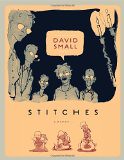
Love Catch That Cookie and its author and illustrator :)
Thank you for the continued support everyone! Happy Holidays!
I remember your post on the process of illustrations for this book and have been looking forward to its release. All of my kids have chased after the Gingerbread Man in preschool/kindergarten and gingerbread cookies have a long history in our family. Can’t wait to buy it! Thanks for this post.
What a wonderful post Jennifer. Perfect for this time of year. Thanks for opening my eyes by opening your heart.
Thank you, Darlene. My friend is a true inspiration. Happy Holidays!
Thanks for the nice shout-out, Kathy! Have fun making the cookies. When you eat them, be sure to bite the heads off first so the G-men don’t feel any pain. :)
Me, too.
Jama,
Will do. Ha ha! That’s funny.
Kathy
Wish you much more in the new year.
Kathy
Heather,
I know they will enjoy the book. You going to make the cookies?
Kathy